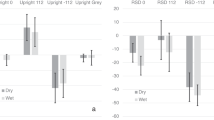Summary
In weightlessness most subjects feel themselves, and see the visual surroundings, in either an upright or an upside-down orientation although the gravitational force vector is missing. According to a theory of gravity perception, these illusions of positional and visual verticality are assumed to be caused by the force-independent z-axis bias of vestibular and somatic graviceptors. This hypothesis is tested by comparison of measurements of the joint bias in normal gravity with reports of probands in space flight. The expected correlations between the sign of the biases and the occurrence of the respective illusions appear in fact to exist, as well as a negative correlation to incidences of space sickness. If confirmed in a larger sample, the presumed dependency may eventually afford a predictive test of both phenomena.
Similar content being viewed by others
Abbreviations
- SPV:
-
subjective positional vertical
- SVV:
-
subjective visual vertical
- SHP:
-
subjective horizontal position
- G :
-
magnitude of normalized gravitoinertial acceleration: actual acceleration (b) divided by g=981 cm s−2
- G :
-
b g −1
- G r :
-
normalized magnitude of acceleration exerted by sled centrifuge per centimeter radius: b g−1 r −1=G r −1=ω2 g −1=0.0145 G cm−1
- BA:
-
binaural axis of subject
- CA:
-
axis of sled centrifuge
References
Diamond SG, Markham CH (1991) Otolith function in hypo- and hypergravity: relation to space motion sickness. Acta Otolaryngol (Stockh) 481 [Suppl]:19–22
Diamond SG, Markham CH (1991) Prediction of space motion sickness susceptibility by disconjugate eye torsion in parabolic flight. Aviat Space Environ Med 62:201–205
Friederici AD, Levelt WJM (1990) Spatial reference in weightlessness: perceptual factors and mental representations. Perception and Psychophysics 47:235–266
Glasauer S, Mittelstaedt H (1992) Determinants of orientation in microgravity. Acta Astronautica 27:1–9
Lackner J (1992) Sense of body position in parabolic flight. Ann NY Acad Sci 656:329–339
Matsnev El, Yakovleva IY, Tarasov IK, Alekseyev VN, Kornilova LN, Mateev AD, Gorgiladze GI (1973) Space motion sickness: phenomenology, countermeasures, and mechanisms. Aviat Space Environ Med 54:312–317
Mittelstaedt H (1983) A new solution to the problem of the subjective vertical. Naturwissenschaften 70:272–281
Mittelstaedt H (1985) Subjective vertical in weightlessness. In: Igarashi M, Black O (eds) Vestibular and visual control on posture and locomotor equilibrium. 7th International Symposium in the International Society of Posturography, Houston Texas. Karger, Basel, pp 139–150
Mittelstaedt H (1986) The subjective vertical as a function of visual and extraretinal cues. Acta Psychol (Amst) 63:63–85
Mittelstaedt H (1987) Inflight and postflight results on the causation of inversion illusion and space sickness. In: Sahm PR, Jansen R, Keller MH (eds) Procedings of the Norderney Symposium on Scientific Results of the German Spacelab Mission D1 (Norderney, 27–29 August 1986). DFVLR, Cologne, pp 525–536
Mittelstaedt H (1988) Determinants of space perception in space flight. Adv Otorhinolaryng 42:18–23
Mittelstaedt H (1988) The information processing structure of the subjective vertical. A cybernetic bridge between its psychophysics and its neurobiology. In: Marko H. Hauske G, Struppler A (eds) Processing structures for perception and action. VCH, Weinheim, pp 217–263
Mittelstaedt H (1989) The role of the pitched-up orientation of the otoliths in two recent models of the subjective vertical. Biol Cybern 61:405–416
Mittelstaedt H (1991) Interactions of form and orientation. In: Ellis SR (ed) Pictorial communication in virtual and real environments. Taylor & Francis, London, pp 377–389
Mittelstaedt H (1992) Somatic versus vestibular gravity reception in man. Ann NY Acad Sci 656:124–139
Mittelstaedt H, Fricke E (1988) The relative effect of saccular and somatosensory information on spatial perception and control. Adv Otorhinolaryng 42:24–30
Oman CM, Lichtenberg BK, Money KE, McCoy RK (1986) MIT/Canadian vestibular experiments on the Spacelab-1 mission. IV. Space motion sickness: symptoms, stimuli, and predictability. Exp Brain Res 64:316–334
Yakovleva IY, Kornilova LN, Syrykh GD, Tarasov IK, Alekseyev VN (1981) Results of studies of vestibular function and spatial perception in the crews of the first and second expeditions aboard Salyut-t station. Space Biol-Aerospace Med 15:25–30
Young LR, Oman CM, Watt DGD, Money KE, Lichtenberg BK, Kenyon RV, Arrott AP (1986) MIT/Canadian vestibular experiments on the Spacelab-1 mission. 1. Sensory adaptation to weightlessness and readaptation to one-g: an overview. Exp Brain Res 64:291–298
Author information
Authors and Affiliations
Rights and permissions
About this article
Cite this article
Mittelstaedt, H., Glasauer, S. Illusions of verticality in weightlessness. Clin Investig 71, 732–739 (1993). https://doi.org/10.1007/BF00209728
Received:
Revised:
Accepted:
Issue Date:
DOI: https://doi.org/10.1007/BF00209728




